If you’ve never roasted spaghetti squash, the first time you stare at it on your kitchen counter can be intimidating. I mean, how in the world does a hard-skinned gourd transform into tender strands that look like angel hair? Well, dear reader, with one of my favorite kitchen hacks up your sleeve, it’s actually really easy.
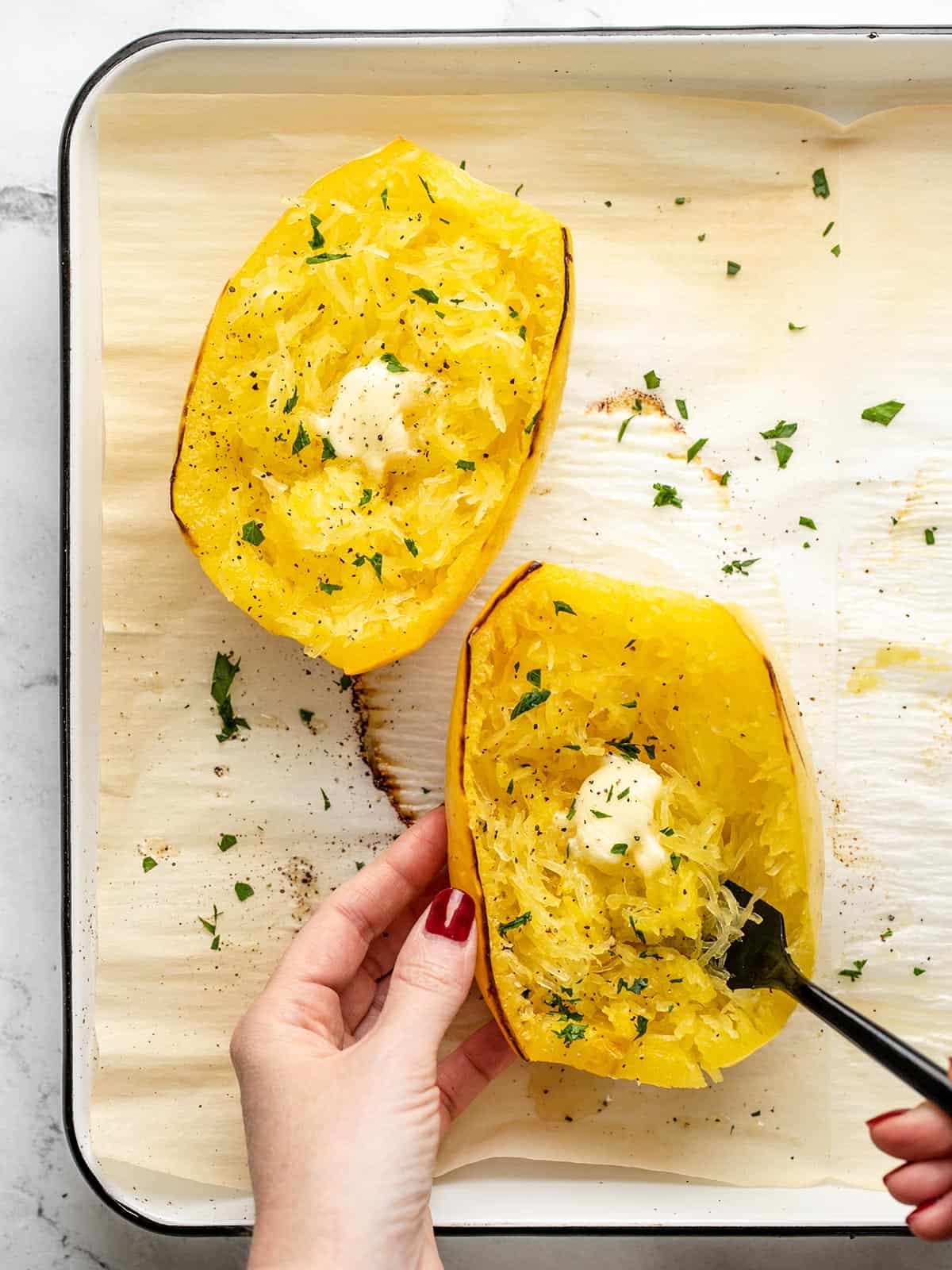
What Is Spaghetti Squash?
Surprisingly, considering all of its savory preparations, spaghetti squash is a fruit, just like every other squash. Its bright canary yellow and football-like shape makes it easy to recognize among its more famous cousins, butternut and acorn. No matter, as Spaghetti is the unicorn of winter squashes. Once it’s cooked, its neutral-flavored flesh separates into long, translucent strings that resemble angel hair pasta. Try that with butternut squash! (Spoiler alert: you will fail miserably.) PS, spaghetti squash seeds are edible, so don’t throw them out.
HOW TO Make Cutting Easy
If you think you need super-human strength and wolverine-like blades to cut through this hard-skinned squash, you would be correct. But as I mentioned, I have tricks that will help you keep all of your digits on your hands where they belong. After a nice little rinse in your sink, pierce your squash about a dozen times with a fork. Then pop it in your microwave and cook it for five minutes. The heat transforms its hard shell into something a bit more manageable. This trick works with all hard-skinned squashes.
How To Cut Spaghetti Squash
- While it’s getting nuked into submission, prepare your work surface. First, place a damp paper towel under your cutting board, so it doesn’t slip. Then place a thick dish towel on your cutting board so the squash doesn’t slip.
- Place the softened squash long side down on the dish towel on top of your cutting board. Slice off both ends, and create a flat surface to help stabilize the squash on your board.
- Next, set it upright on its newly trimmed bottom and cut straight down the middle from tip to end. Alternatively, you can set it on its side and slice it into rounds. Yes, that will take longer than counting out $20 in nickels and dimes. But you do you.
How To Get SEEDS OUT OF Squash
Once the squash has been cut open, use a soup spoon to scrape out the fifty thousand seeds in its cavity. Don’t go crazy here, as it’s easy to scrape a ton of flesh out along with the seeds. If you want, clean the seeds and reserve them for roasting. Boom! You’re ready to go! Check out my simple recipe below for Roasted Spaghetti Squash.
What can you serve with Spaghetti Squash?
Spaghetti squash has a very neutral flavor, which makes it a perfect canvas for All. Of. The. Things. You can separate its strands and dress them simply in salted butter (my fave!) or go all out:
- Top the strands with a hearty sauce, like The Best Easy Weeknight Pasta Sauce.
- Use it to bulk up meals or in place of pasta. Try adding it to Beth’s Roasted Red Pepper and Feta Frittata or Garlic Noodles With Beef And Broccoli.
- You can also stuff spaghetti squash. Try Apple Walnut Stuffing or the stuffing from this delicious Pesto Stuffed Shells recipe.
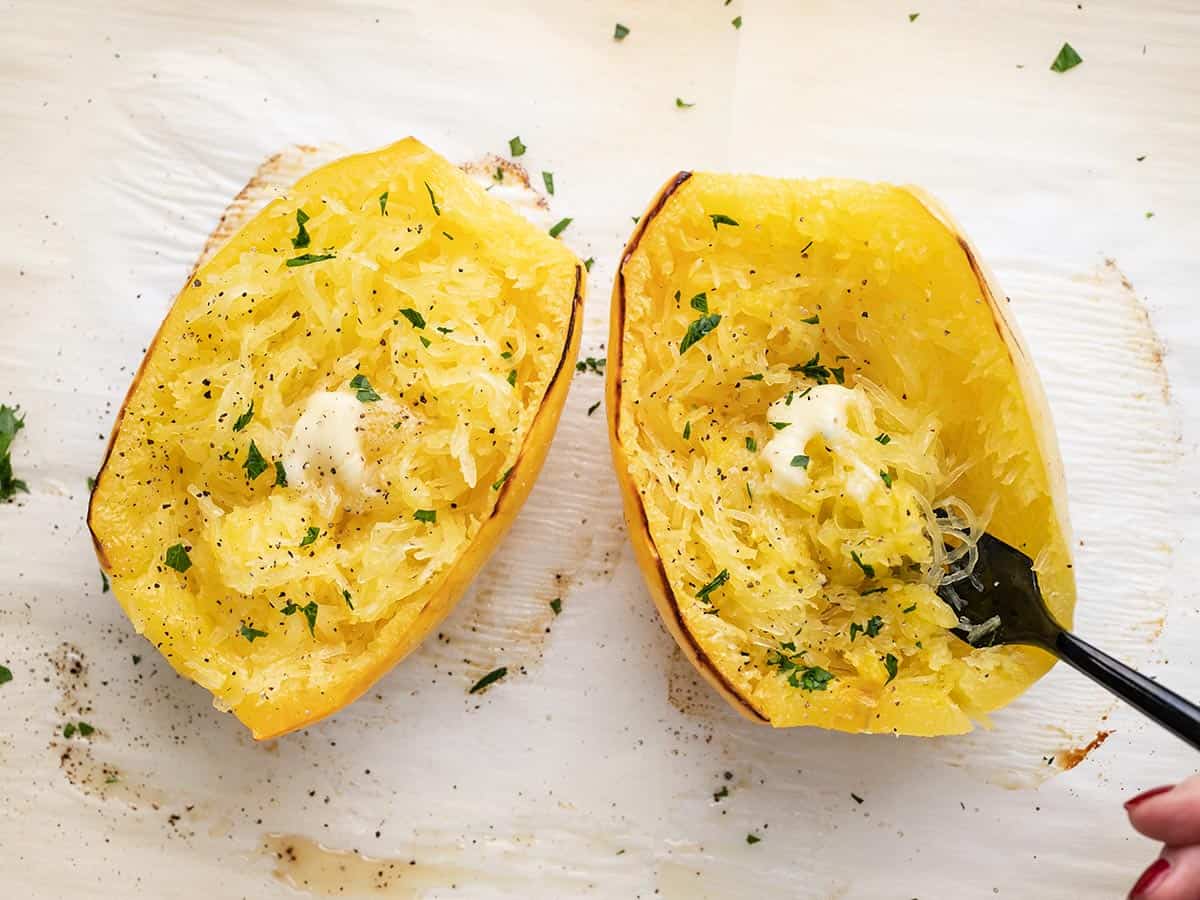
Roasted Spaghetti Squash
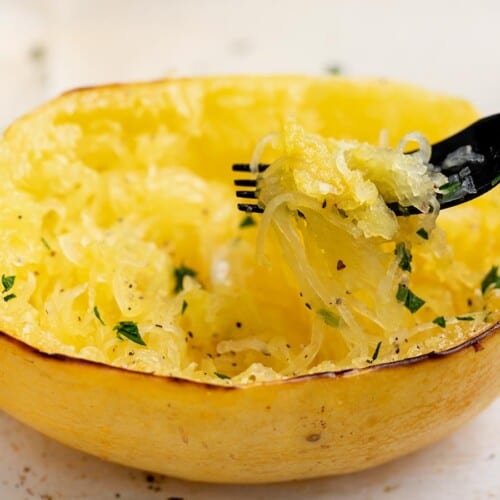
Ingredients
- 1 spaghetti squash, (approx. 1.3 lbs) ($1.05)
- 1 Tbsp olive oil ($0.15)
- 1/2 tsp salt ($0.01)
- 2 Tbsp salted butter ($0.30)
Instructions
- Place a rack in the center of your oven and preheat it to 400°F. Line a sheet pan with parchment. Place a dish towel on your cutting board to stabilize the squash, and then trim off 1/4 inch from both ends.
- Place the cut bottom of the squash on your cutting board with the stem side facing up. Cut down the center of the squash, from the top to the bottom.
- Use a soup spoon to scrape out all of the seeds in the cavity of the squash. If you wish, reserve them for roasting.
- Brush olive oil on both halves of the squash and sprinkle salt on them.
- Place the halves cut side down on the sheet pan. Roast your squash for 30 to 45 minutes or until a fork easily pierces the skin.*
- Allow the squash to cool until it's comfortable to hold. Use a fork to scrape the squash halves in one direction, creating spaghetti-like strands.
- Dress with butter and serve.
See how we calculate recipe costs here.
Equipment
Notes
Nutrition
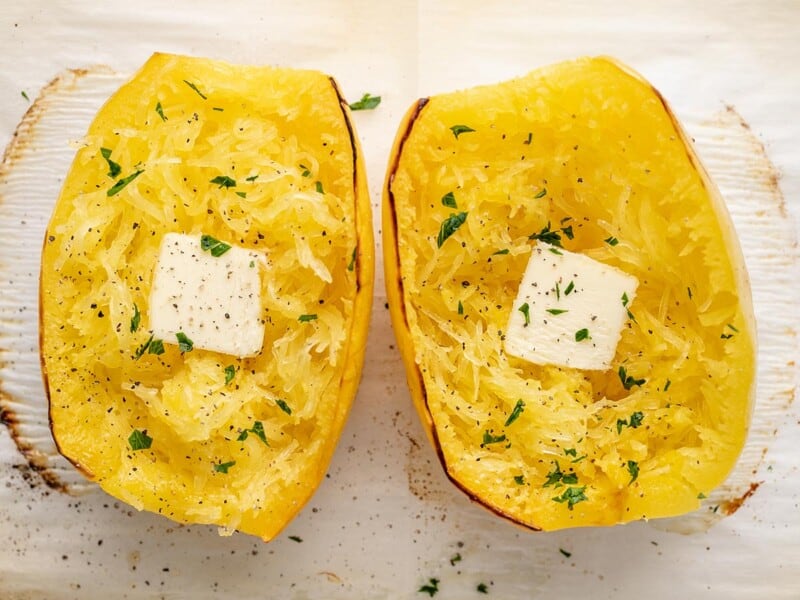
How to Make Roasted Spaghetti Squash – Step by Step Photos
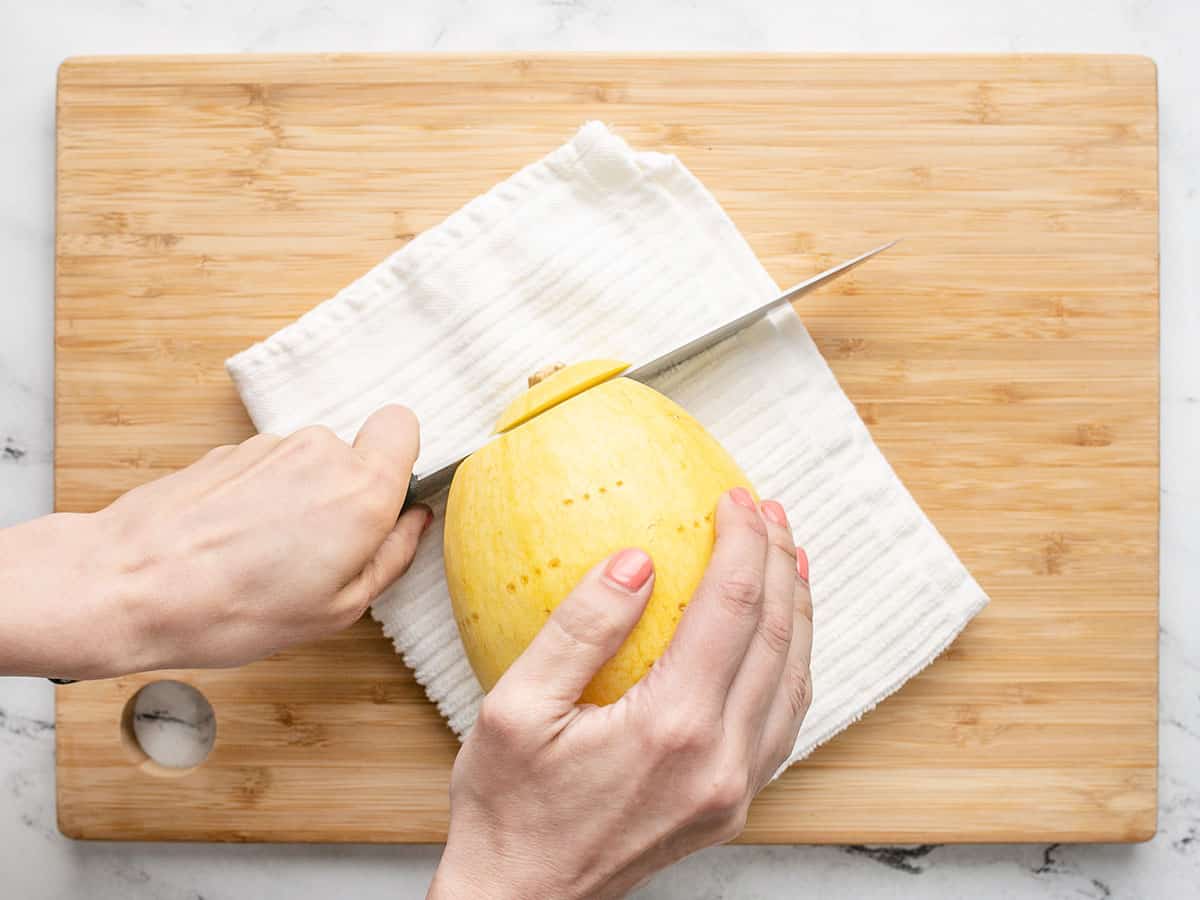
Place a rack in the center of your oven and preheat to 400°F. Line a sheet pan with parchment paper. Place a dish towel on your cutting board and put the spaghetti squash on top of it. Use a chef’s knife to cut 1/4 inch off both ends.
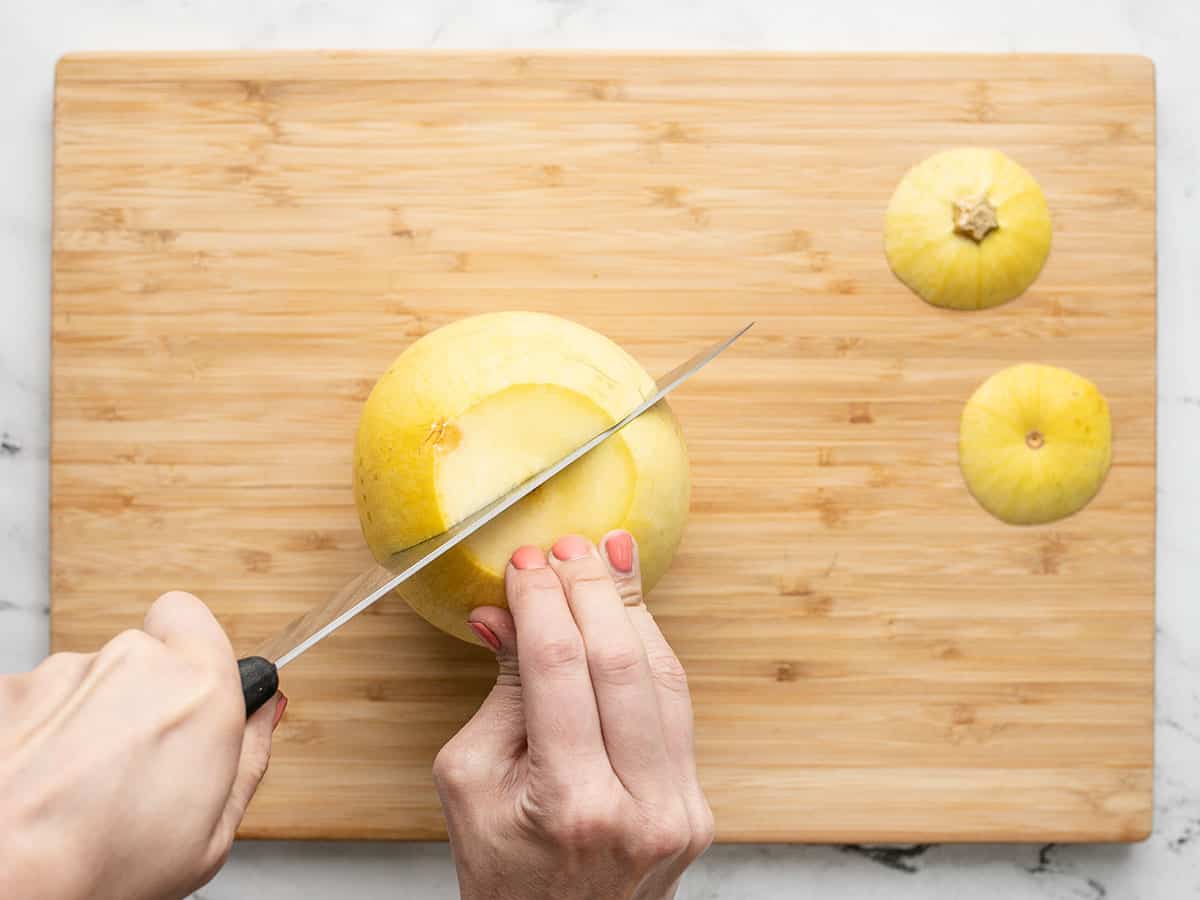
Place the bottom of the squash on the board, with the tip facing up. Hold the squash with one hand and slice it down the middle with the other.
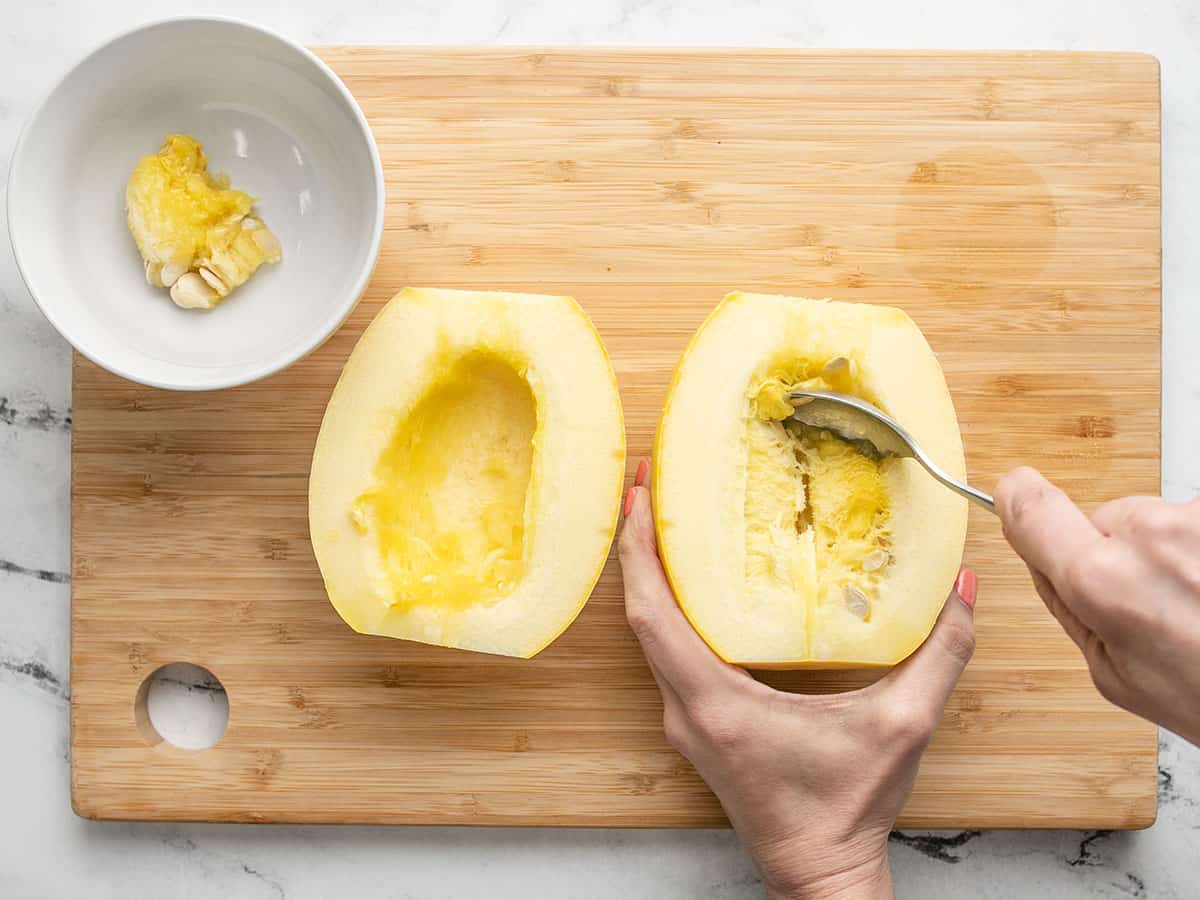
Use a soup spoon to scrape out the seeds in the cavity of the squash, taking care not to remove the flesh. If you wish, reserve the seeds for roasting.
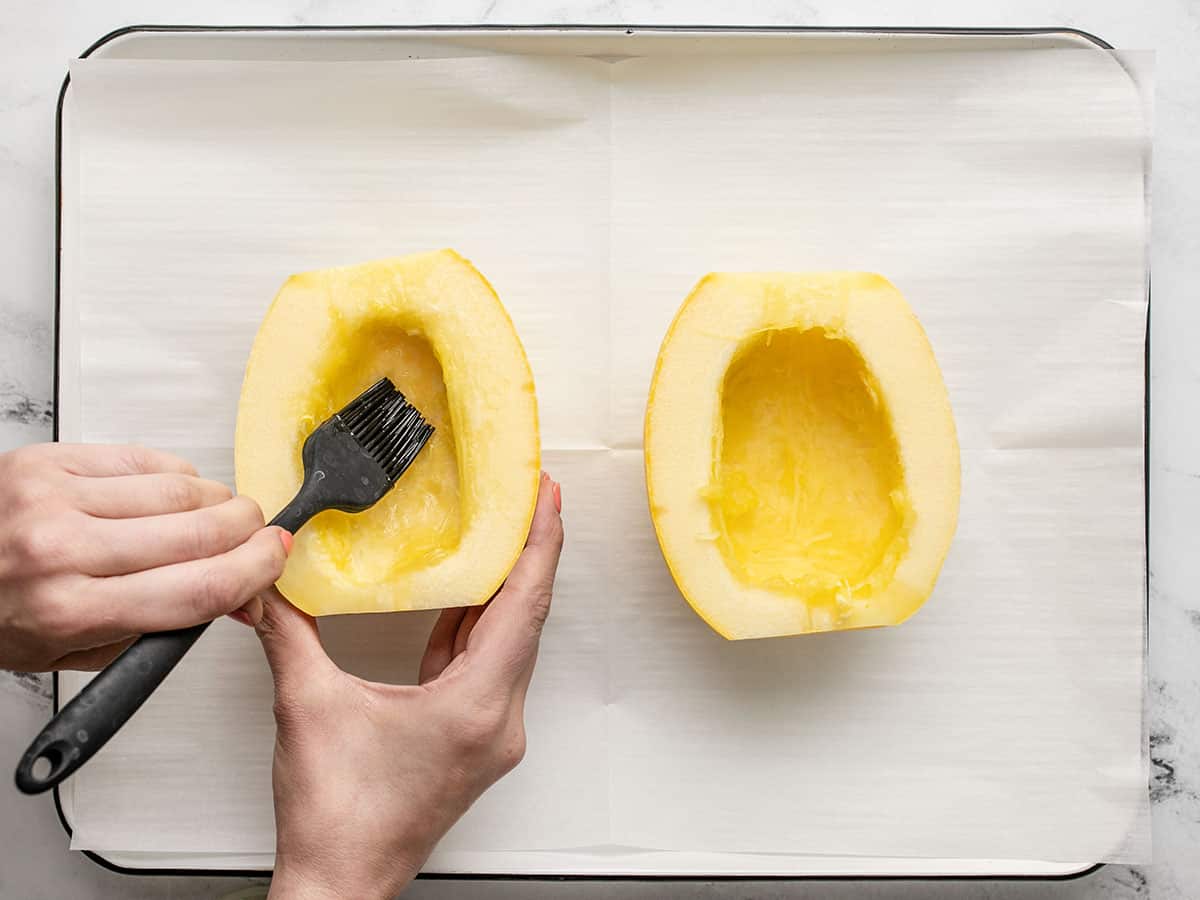
Place the spaghetti squash halves on a sheet pan, cut side up. Brush one tablespoon of olive oil on the squash halves. Drizzle with 1/2 teaspoon of salt.
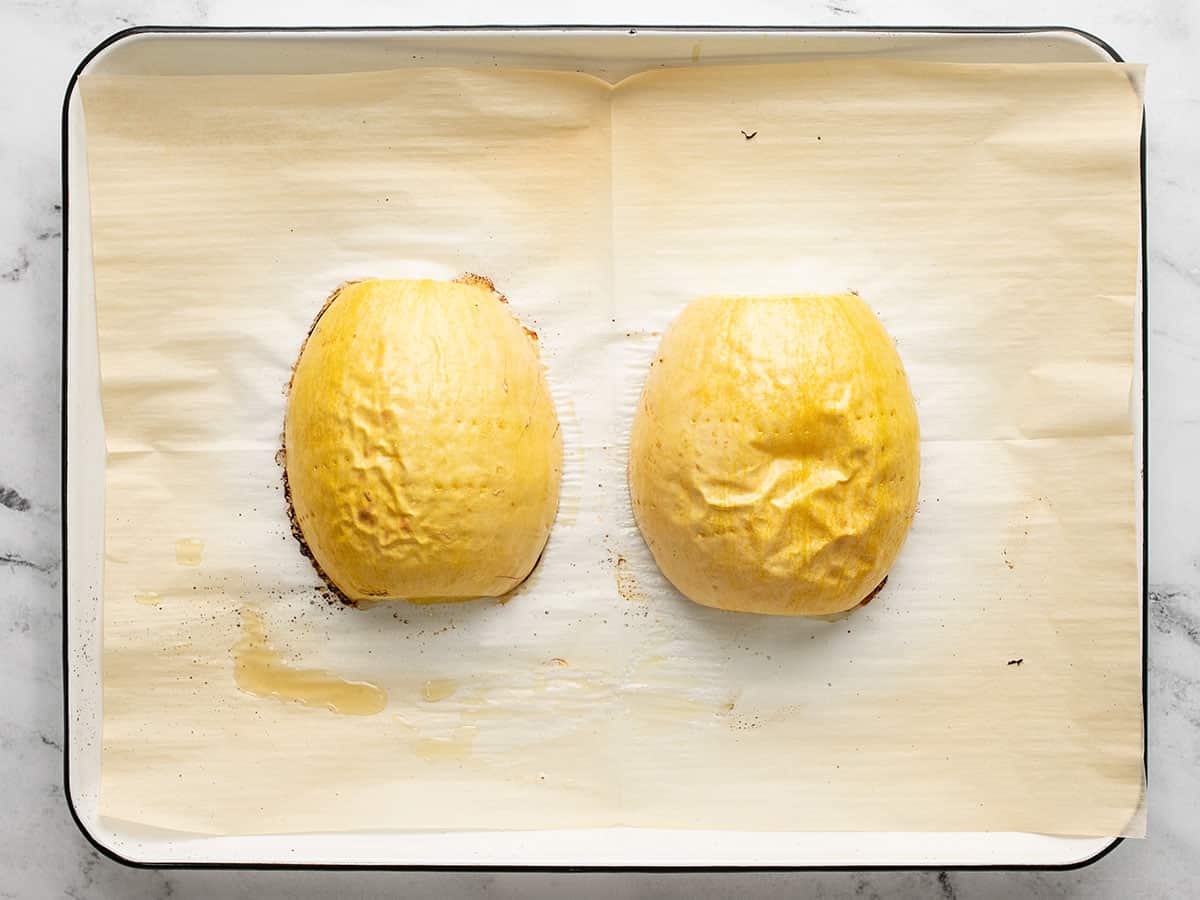
Turn the spaghetti squash halves face down on the sheet pan and roast for 35 to 45 minutes, or until a fork pierces the skin with no resistance.
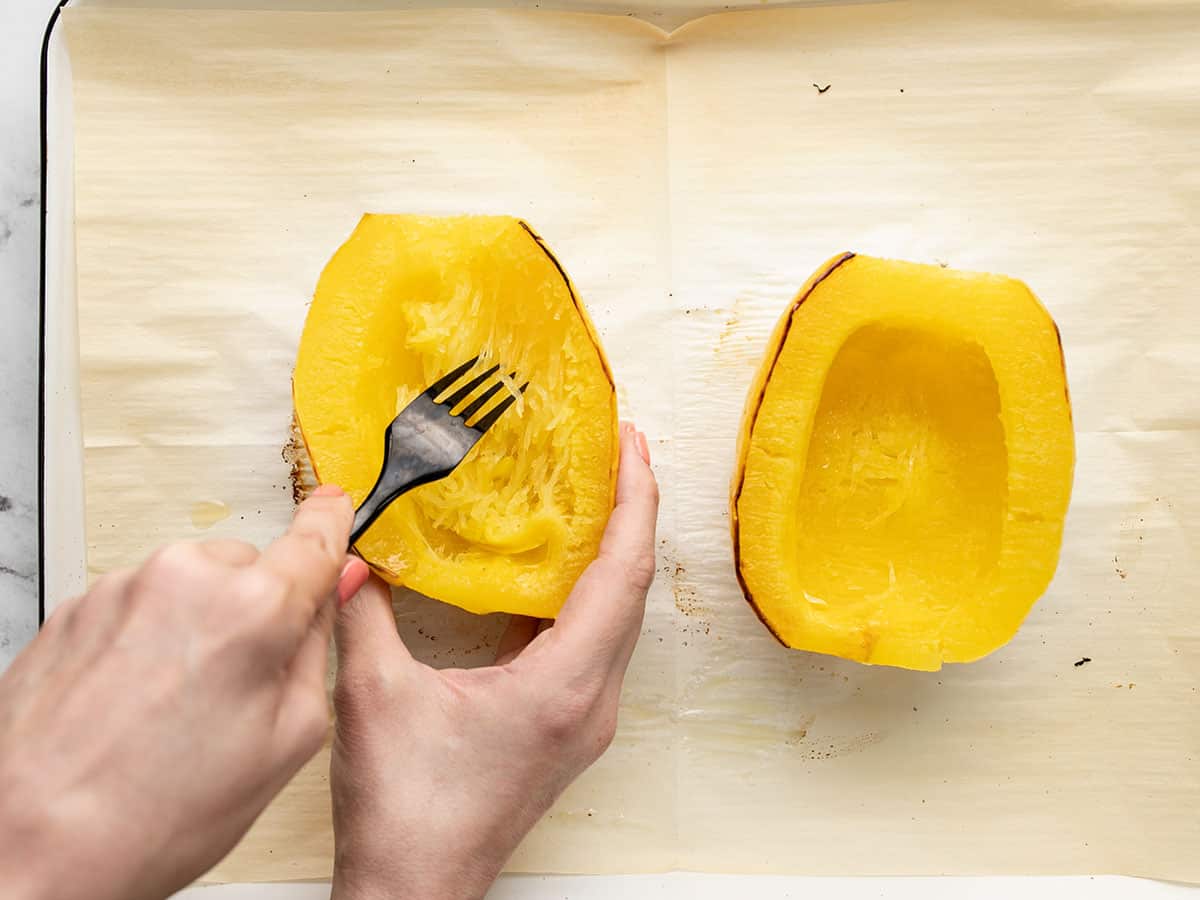
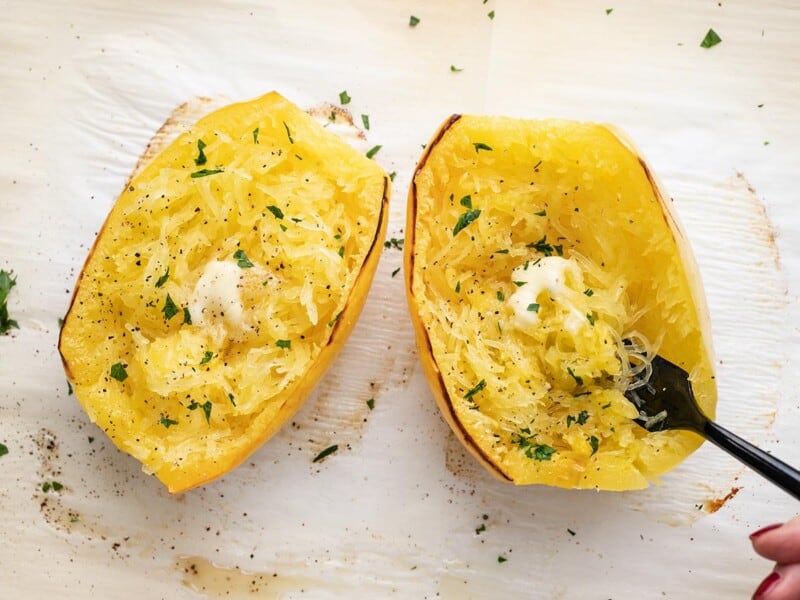


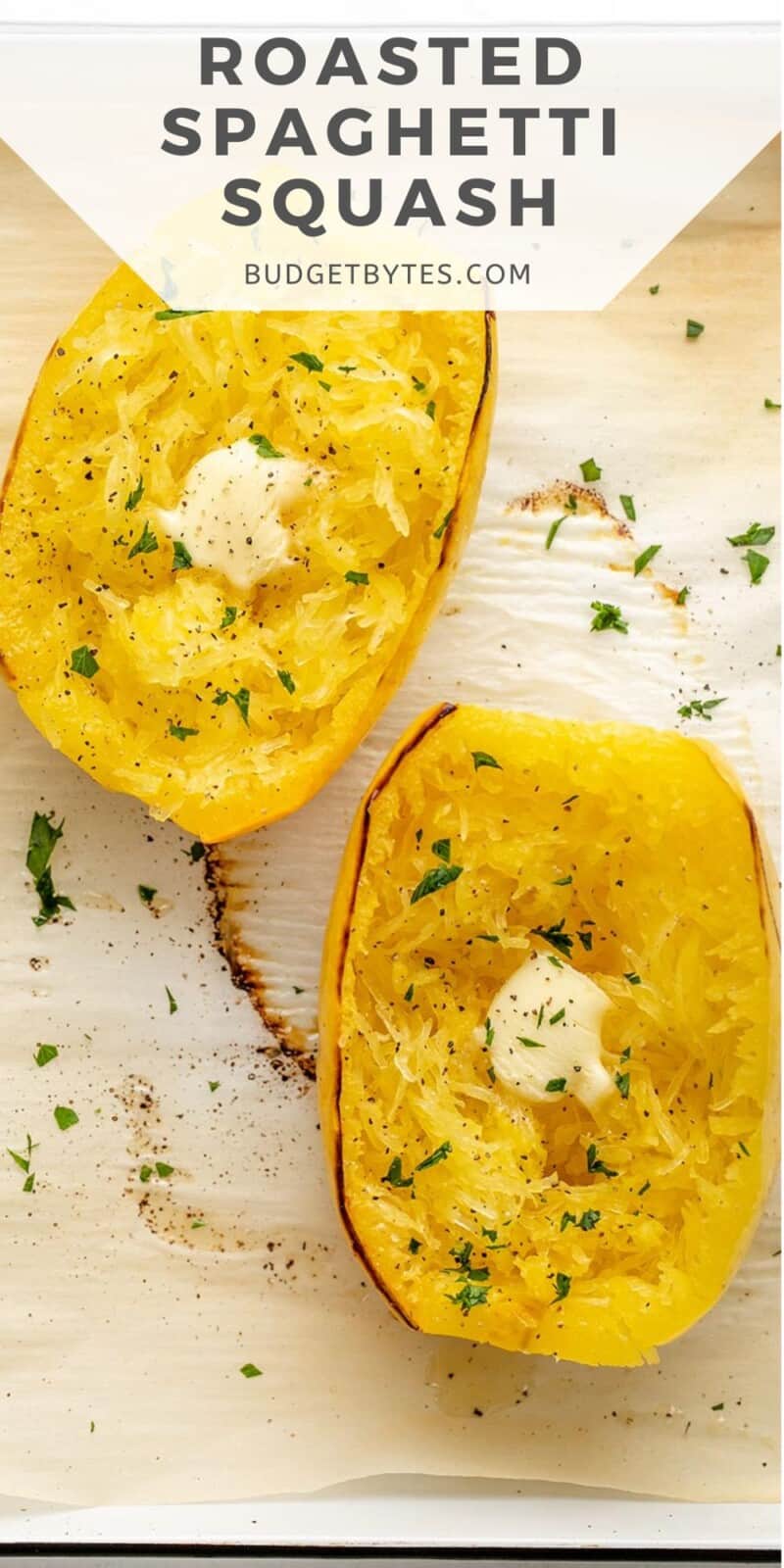
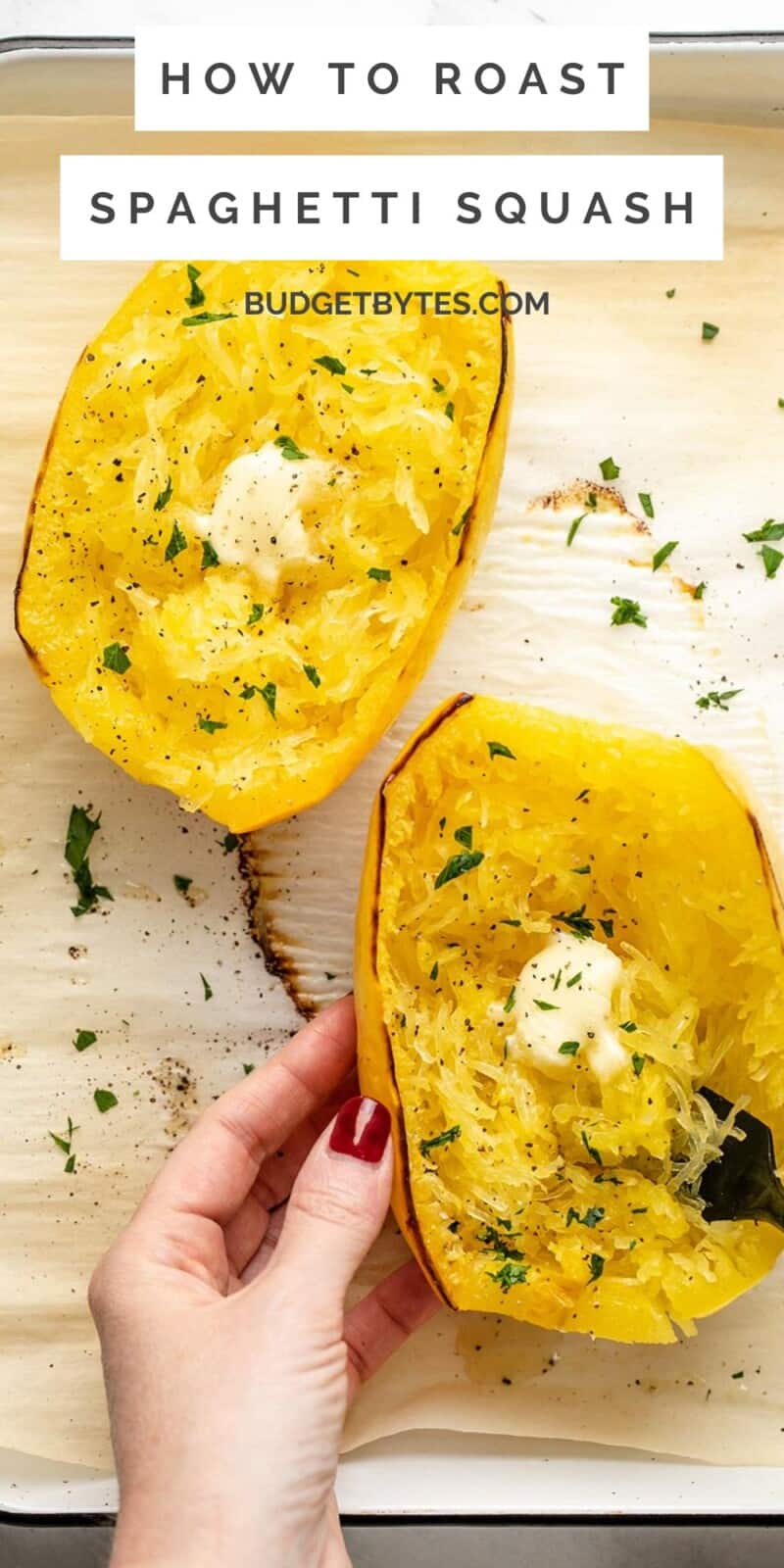
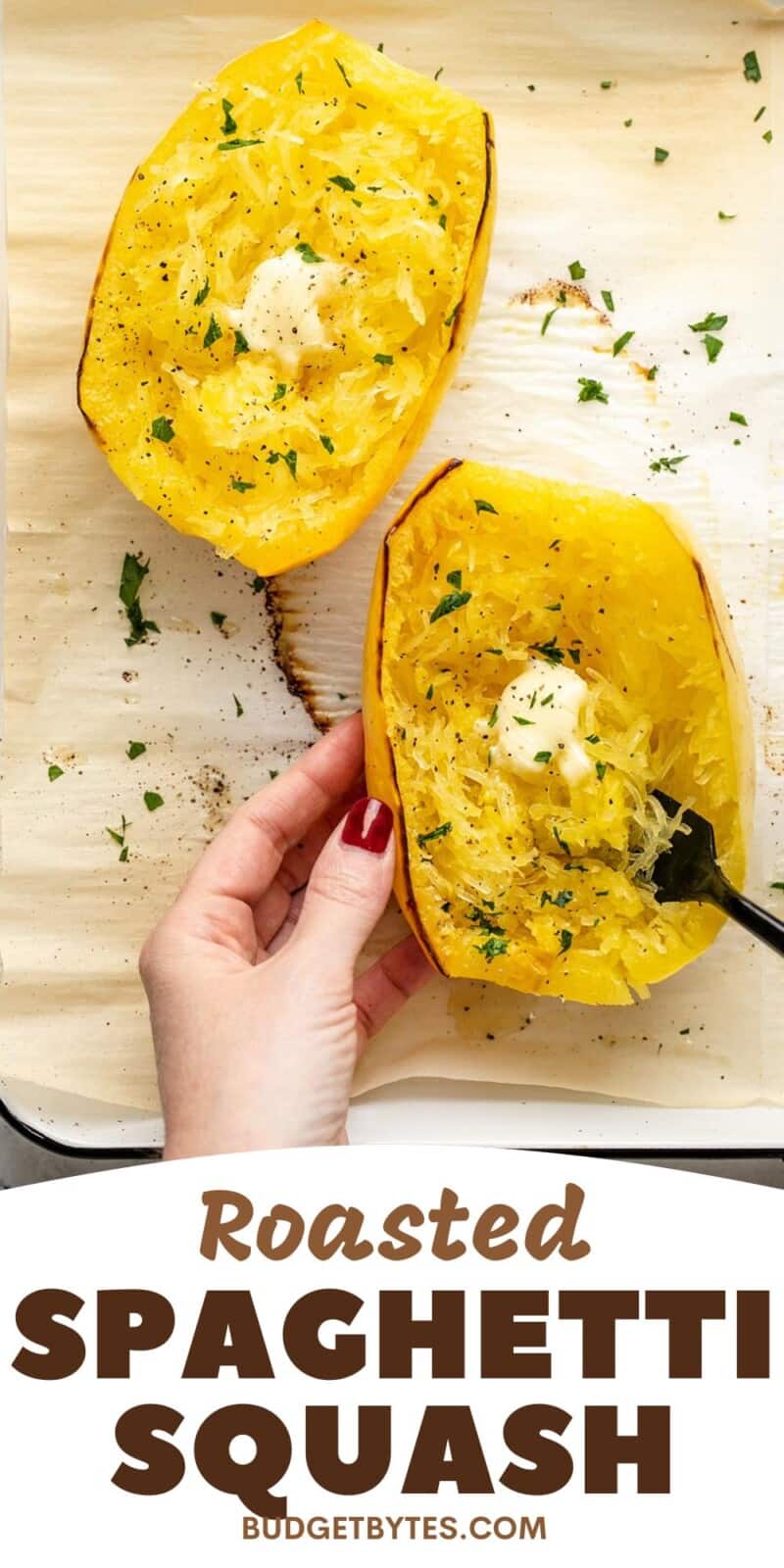
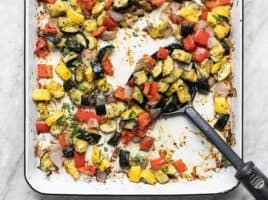
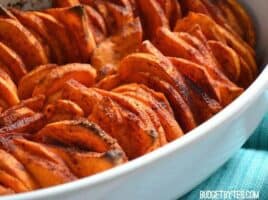
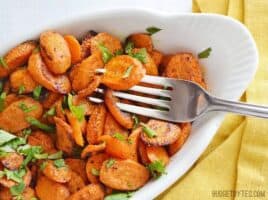
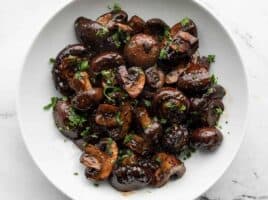
If I use the microwave technique to help cut the squash prior to roasting, how else could I determine if it’s done in oven? If I already “cooked” the skin in microwave, I would assume it would already be fork tender. Thanks for any tips!
The microwaving portion just makes it soft enough to cut through the squash with ease, but the meat of the squash will remain mostly uncooked and not fork tender. You’ll know it’s done in the oven when you can easily flake it with a fork!
One trick I use is to set the squash on my largest cutting board on my kitchen floor. I then kneel next to the squash to cut it in half. This gives me a height and strength advantage and makes it easier to cut.
I cook the entire squash at 375 to 400 degrees for an hour. Depending on the size. When it’s done I cut it in half then remove the seeds. Super easy that way!
Delicious! I’ve always loved roasted spaghetti squash and this recipe made it even tastier and easier.
I make this all the time. Add so many extras. Italian sausage, mushrooms, chicken kalmata olives, green onions, pine nuts, a variety of cheese.
It’s so delicious.
For nice long strands of spaghetti squash, like real spaghetti, slice the squash on the short side, into rings, and then roast. Delicious!
For a WOW! taste.
Try topping with grated blue cheese.
OOOH!!!! That sounds amazing! XOXO -Monti
Via the internet, I have preferred cutting the squash around the middle only. It gives you longer strands and is easier to cut and just as easy to remove the seeds from.
Delicious and easy!!
Love this! But with spaghetti squash you should cut around the equator of the squash, not from pole to pole so you get lovely long strands of squash that you can wrap around a fork.
Back when I worked the most gruelling, underpaid teaching job of the century, I’d stop by this one shop that carried spagetti squash for a while. This job was out by a bustling farming hub so this shop carried a lot of vegetables you could not get anywhere else, like black kale, spagetti squash and the best honey.
With spagetti squash I usually prepared it the same way as you’ve done here, then fill it with a meatsauce my sister taught me for homemade pizza, covered it with my favorite cheese and went back into the oven to melt the cheese, The result was a pizzaflavored spagetti-squash that was to die for. Eating it straight out of the halved spagetti squash and watching BB99 was a delight and made the job almost bearable.
I hit reply too soon. I suggest trying that, it is delicious. Great recipie Monti! Ps, I think you meant «Allow the spagetti squash to cool» and not «all.» =)
Way too many typos in this blog these days, ugh.
Just in case Monti looked up in the recipe text and was confused by this comment:
Just wanted to clarify that Tutta was referring to the instructions interspersed with the photos. This typo is (at the time of this writing) at the beginning of the first line in the text under the picture of the fork scraping the cooked squash (second to last photo).
I believe there is also an error either in the total cost at the top of the article or the costs imbedded in the recipe for each ingredient. I normally don’t consciously pay attention to the pricing (and realize this varies by where one lives, time of year etc.) but I did notice that the math was way off. If the pricing imbedded in the article is what you meant, then the total cost for the recipe would be $2.15 instead of $5.62 (and you got a fantastic deal on the spaghetti squash, I might add, if it was only $0.79 for 1 1/3 lb). If the pricing at the top of the article is correct, there is a typo in the imbedded pricing for ingredients (probably the price of the squash… and wow spaghetti squash, even if you bought organic, is incredibly expensive per pound where you are for being in season if you really used a 1 1/3 lb squash that cost $4.26… maybe the weight of the squash listed in the ingredients is off and that is what threw off the calculations?).
Sorry to nit pick since none of this impacts following the recipe but figured you would want to know since proof reading one’s own typing is always more difficult than proof reading somebody else’s. Nice, straightforward instructions for a timely recipe for the northern hemisphere (spaghetti squash is ready in the garden so my family and a lot of my neighbors have been including roasted spaghetti squash in our meal planning the last few weeks and will continue doing so for the foreseeable future… was quite the bumper crop this year! Thankfully they keep well.).
Yep, you’re right! Sorry about that error, it’s all fixed now. :)
$1.20 for two tablespoons of butter seems off, too. That would be $4.80 a stick, or almost $20/pound. I know prices are going crazy but it’s not that bad yet, right?
Oh, good gravy! My math game is so off. Fixed it! Thank you! XOXO -Monti
I just bought 2 squashes on special for $0.59 per lb, making the price for this recipe right on target for me in central NC
Hi, I also noticed that this suggests serving with “heart sauce”, which I’m guessing should be “hearty”. :)
I’m very excited to try this recipe! I accidentally grew spaghetti squash this year (thanks for the cross-pollination, bees!) and am looking for delicious ways to enjoy them.
Thanks!!